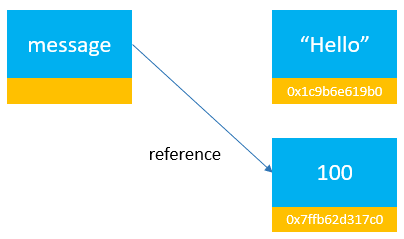Summary: in this tutorial, you’ll learn about dynamic typing in Python and how it works.
Introduction to dynamic typing in Python #
In some programming languages such as Java or C#, when declaring a variable, you need to specify a data type for it.
For example, in Java, you can declare a variable with the type String and initializes its value as follows:
String message = "Hello";Code language: JavaScript (javascript)Behind the scenes, Java creates a new String object whose value is "Hello". It also creates a variable called message with type String and references the message variable to the String object.
In statically typed languages, the data types are associated with variables.
Later, if you assign an integer to the message variable, it’s not going to work. The reason is that the message variable is already associated with the String type, not the integer type.
Unlike statically typed languages, Python is a dynamically typed language. When declaring a variable in Python, you don’t specify a type for it:
message = 'Hello'Code language: JavaScript (javascript)In Python, the message variable is just a reference to an object which is a string. There is no type associated with the message variable.

If you assign a number to the message variable, it’s perfectly fine:
message = 100In this case, Python creates a new integer object, and the message references to the new integer object:

To determine the type of object that a variable currently references, you use the type() function.
The following example defines a variable named message and assigned it a string 'Hello':
message = 'Hello'
print(type(message))Code language: PHP (php)Output:
<class 'str'>Code language: HTML, XML (xml)When you assign a number to the message variable, type of the object that the message variable references by also changes:
message = 100
print(type(message))Code language: PHP (php)Output:
<class 'int'>Code language: HTML, XML (xml)Summary #
- Python is a dynamically typed language.
- In Python, variables don’t associate with any particular types.
- Use the
type()function to get the type of the objects that variables reference.